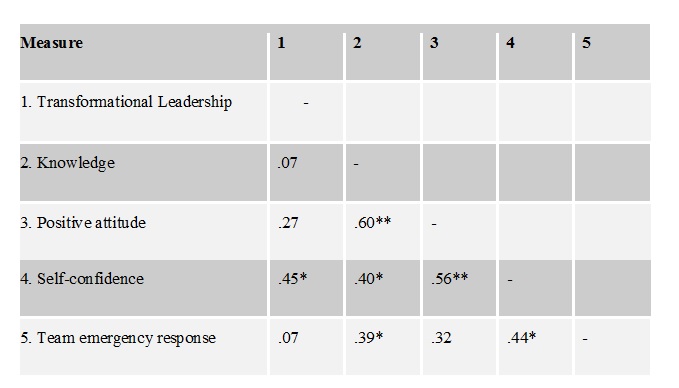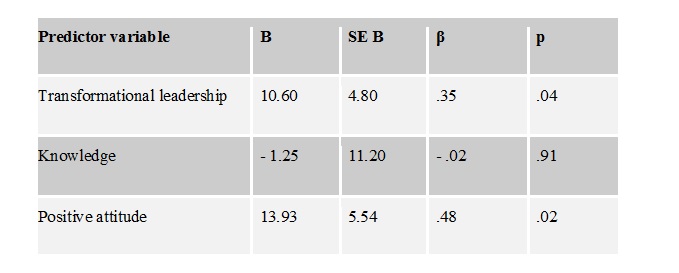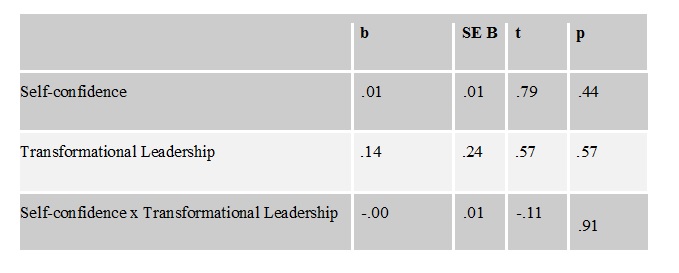Relationships between variables
Relationships between variables
Relationships between variables
We run a correlation to test the first fourth hypothesis.
Table 17
Correlation Matrix

Note. *p<.05, **p<.01
As shown in Table 17, transformational leadership and self-confidence are positively correlated, r(26)=.45, p<.05. So, hypothesis 1 can be confirmed. Also knowledge about the emergency plan and self-confidence are positively correlated, r(29)=.40, p<.05 (hypothesis 2). Hypothesis 3, as well, can be confirmed, because the table shows a strong positive correlation between positive attitude toward emergency plan and self-confidence, r(28)=.56, p=.01. As it was supposed in hypothesis 4, also self-confidence and team emergency response are positively correlated, r(28)=.44, p<.05. Moreover, the table shows another relationship that we haven’t supposed at the beginning of this study. Indeed, also knowledge about the emergency plan and team emergency response are positively correlated, r(33)=.39, p<.05. Finally, another interesting finding not considered in the hypothesis is that also positive attitude and knowledge are strongly positively correlated, r(34)=.60, p<.01.
Predictors of self-confidence
A multiple regression analysis was conducted to predict the level of self-confidence from theknowledge about the emergency plan, the positive attitude toward it and the transformational style of leadership. We considered self-confidence as a criterion and knowledge, positive attitude and transformational leadership as predictors. Results are reported in Table 18.
Table 18
Multiple Regression Analysis (dependent variable: self-confidence)

Note. R²=.65.
For this model, both the transformational leadership t(24)=2.21, p<.05 and the positive attitude t(24)=2.51, p<.05 are significant predictors of the team emergency response. On the other hand, knowledge t(24)= -.11, p=.91 resulted not significant. The relationship between the two predictors and the criterion is positive, meaning that is the level of transformational leadership or of the positive attitude rises, also the level of team emergency response will grow. Moreover, looking at the Bs, we can also notice that the positive attitude has a bigger impact (B=13.93) than the transformational leadership (B=10.60). The overall model, with the three predictors, is able to account for the 65% of the variance in the level of self-confidence.
So, the result provides partial confirmation for the hypothesis 5.
Self-confidence’s moderation effect
We tested the moderator effect of self-confidence between transformational leadership and team emergency response using a regression analysis. Results are reported in Table 19.
Table 19
Moderation Analysis (dependent variable: team emergency response)

Note. R² = .13
Looking at the last column, we can see that the interaction between the two variables is not statistical significant (p=. 91). So we are not able to confirm that the strength of the relationship between transformational leadership e team emergency response is affected by the level of self-confidence (hypothesis 5).
© – MANAGEMENT OF AN EMERGENCY EVACUATION: A LEADER’S PERSPECTIVE – Sara Colangeli







